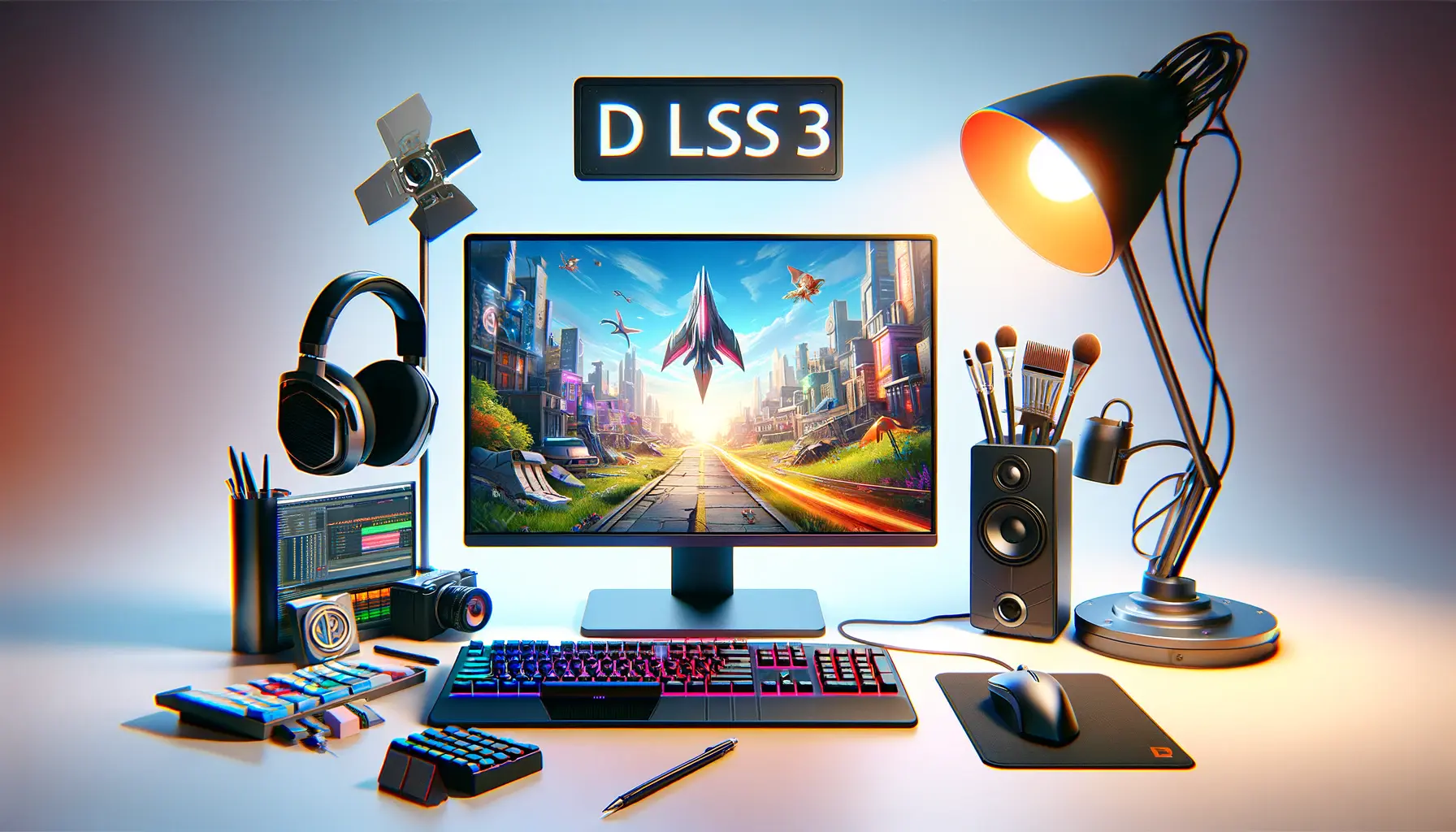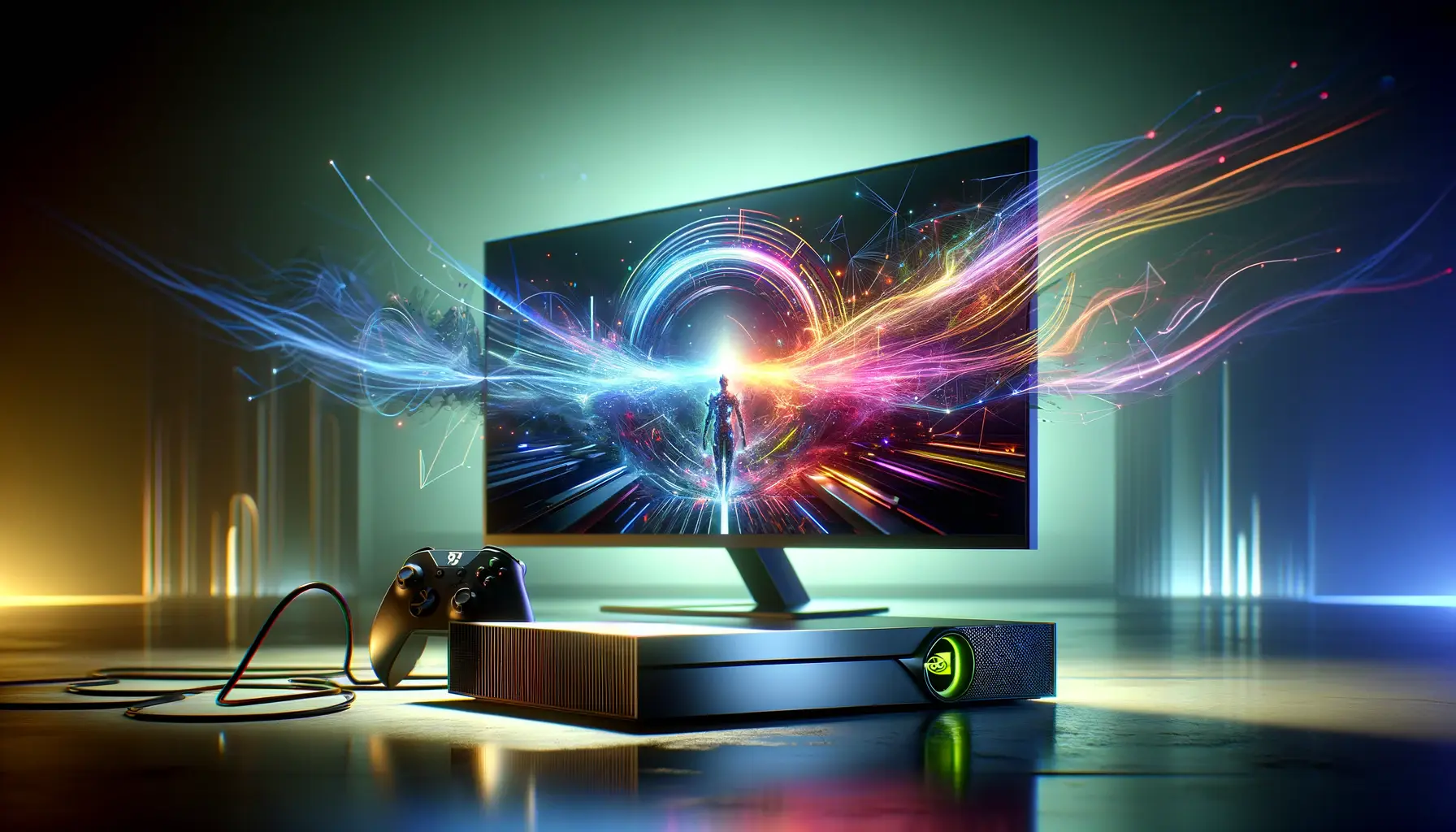The gaming industry is at a pivotal point in its evolution, where the demand for higher fidelity and immersive experiences meets the urgent need for sustainability.
NVIDIA’s Deep Learning Super Sampling (DLSS) 3 technology emerges as a beacon of innovation, addressing both these demands with unprecedented efficiency.
This article delves into how DLSS 3 is revolutionizing the gaming tech landscape, focusing on its role in promoting sustainability without compromising on performance.
At its core, DLSS 3 harnesses the power of artificial intelligence to enhance gaming visuals while significantly reducing the computational load on hardware.
This breakthrough is not just a technical achievement; it’s a step towards a more sustainable gaming future.
By optimizing resource use, DLSS 3 contributes to lower energy consumption and extends the lifespan of gaming hardware, marking a significant leap towards reducing the environmental footprint of gaming.
- The Genesis of DLSS 3
- DLSS 3’s Role in Energy Efficiency
- Enhancing Game Accessibility and Inclusivity
- DLSS 3 and the Future of Gaming Graphics
- DLSS 3 in Competitive Gaming
- DLSS 3 and Game Streaming Services
- DLSS 3’s Impact on Game Development
- Embracing the Future with DLSS 3
- DLSS 3: Frequently Asked Questions
The Genesis of DLSS 3
Understanding DLSS Technology
DLSS, or Deep Learning Super Sampling, is a groundbreaking AI-based rendering technology developed by NVIDIA.
It uses neural networks to analyze thousands of game frames and intelligently upscale lower-resolution images in real-time.
This process allows for smoother frame rates and sharper visuals, all while reducing the strain on graphics processing units (GPUs).
The introduction of DLSS 3 has further refined this process, introducing features like Frame Generation and Ray Tracing AI Acceleration, which together enhance both the efficiency and the visual quality of games.
DLSS 3’s innovative approach to rendering is a game-changer for developers and gamers alike.
It enables the creation of visually stunning games that run smoothly on a wider range of hardware.
This inclusivity not only broadens the gaming market but also encourages the adoption of sustainable gaming practices by making high-quality gaming accessible without necessitating frequent hardware upgrades.
Sustainability: The Impact on Gaming Hardware
The advent of DLSS 3 technology has a profound impact on gaming hardware, primarily by extending the usable life of GPUs.
Traditionally, the relentless pursuit of higher game resolutions and more detailed graphics has led to rapid obsolescence of gaming hardware.
DLSS 3 mitigates this issue by allowing older or less powerful GPUs to produce visuals that rival or exceed those rendered natively on more advanced hardware.
By reducing the need for frequent hardware upgrades, DLSS 3 not only makes gaming more affordable but also contributes to sustainability.
It addresses the environmental concern associated with electronic waste and the carbon footprint of manufacturing new components.
This technology exemplifies how advancements in gaming tech can align with environmental sustainability goals, setting a precedent for future developments in the industry.
DLSS 3 represents a harmonious blend of technological innovation and environmental consciousness, paving the way for a new era of sustainable gaming.
DLSS 3’s Role in Energy Efficiency
The gaming industry’s rapid growth has brought with it an increased focus on energy consumption, a critical aspect of sustainability.
DLSS 3 technology stands at the forefront of addressing this concern by significantly enhancing the energy efficiency of gaming systems.
This section explores how DLSS 3 contributes to reducing the energy footprint of gaming, making it a key player in the pursuit of eco-friendly gaming practices.
Reducing Power Consumption
One of the most direct impacts of DLSS 3 on sustainability is its ability to lower the power consumption of gaming PCs and consoles.
By efficiently upscaling lower-resolution images to higher fidelity outputs, DLSS 3 allows games to run at advanced settings without the need for maximum GPU power draw.
This reduction in energy usage is crucial, considering the environmental implications of the global energy consumption associated with gaming.
- Enhanced Performance at Lower Power: DLSS 3 enables games to achieve higher frame rates and resolutions with significantly less power, reducing the overall energy demand of gaming devices.
- Longer Lifespan of Hardware: By diminishing the need for GPUs to operate at full capacity, DLSS 3 contributes to a longer lifespan for gaming hardware, indirectly decreasing the energy and resources required for manufacturing new devices.
Implications for Game Development
The integration of DLSS 3 into game development has far-reaching implications for energy efficiency.
Game developers can now design visually stunning games without being constrained by the power limitations of consumer hardware.
This shift not only democratizes high-quality gaming experiences but also aligns game development with sustainability goals.
- Optimized Game Design: Developers can optimize their games for efficiency, knowing that DLSS 3 will ensure high-quality visuals without excessive power use.
- Sustainability in Development: The adoption of DLSS 3 encourages a sustainability-focused approach in the game development process, promoting practices that consider the environmental impact of gaming.
The role of DLSS 3 in enhancing energy efficiency extends beyond just the operational phase of gaming; it influences the entire lifecycle of gaming hardware and the development process of games, marking a significant step towards sustainable gaming practices.
Enhancing Game Accessibility and Inclusivity
DLSS 3 technology not only revolutionizes gaming performance and sustainability but also plays a pivotal role in enhancing game accessibility and inclusivity.
By enabling high-quality gaming experiences on a broader range of hardware, DLSS 3 effectively lowers the entry barrier to the latest gaming titles.
This section delves into how DLSS 3 contributes to making gaming more accessible and inclusive for a wider audience.
At the heart of DLSS 3’s contribution to accessibility is its ability to upscale games to higher resolutions without the need for high-end hardware.
This democratization of gaming technology means that more players can enjoy the latest games without investing in expensive upgrades.
The following points highlight DLSS 3’s impact on gaming accessibility and inclusivity:
- Broader Hardware Compatibility: DLSS 3 allows games to run smoothly on older or mid-range systems, expanding the gaming community by including those with limited access to the latest hardware.
- Cost-Effective Gaming Solutions: By reducing the need for frequent hardware upgrades, DLSS 3 makes gaming more affordable, welcoming a larger demographic of gamers.
Impact on Diverse Gaming Communities
The inclusivity fostered by DLSS 3 extends beyond hardware accessibility.
It also has a profound impact on diverse gaming communities around the world.
By making high-quality gaming experiences more accessible, DLSS 3 helps bridge the gap between different socio-economic groups within the gaming community.
This inclusivity promotes a more diverse and vibrant gaming culture, where more players can share in the latest gaming experiences regardless of their hardware limitations.
- Global Reach: DLSS 3’s efficiency enables gamers from regions with varying access to technology to enjoy advanced gaming experiences, fostering a more inclusive global gaming community.
- Support for Indie Developers: With DLSS 3, indie developers can create games with high-quality visuals that are accessible to a wider audience, encouraging diversity in game development and content.
DLSS 3’s role in enhancing game accessibility and inclusivity is a testament to how technological advancements can bridge divides within the gaming community, making the world of gaming a more inclusive space for everyone.
DLSS 3 and the Future of Gaming Graphics
The introduction of DLSS 3 by NVIDIA has not only set a new standard for game performance and sustainability but also charted a course for the future of gaming graphics.
This technology’s ability to deliver high-resolution, high-frame-rate gaming experiences on a wide range of hardware is transforming expectations and possibilities within the gaming industry.
Let’s explore the implications of DLSS 3 for the future of gaming graphics and how it’s shaping the next generation of gaming experiences.
DLSS 3’s innovative approach to rendering, combining AI-driven upscaling with frame generation, represents a significant leap forward in gaming technology.
This leap is not just about making games look better; it’s about redefining what is possible in real-time rendering.
The following aspects highlight the transformative impact of DLSS 3 on the future of gaming graphics:
- Real-Time Ray Tracing: With DLSS 3, the dream of real-time ray tracing becoming the standard for gaming graphics is closer to reality. By significantly reducing the performance hit associated with ray tracing, DLSS 3 enables more games to incorporate this advanced lighting technique, enhancing realism and immersion.
- AI-Driven Visual Enhancements: The AI component of DLSS 3 goes beyond simple upscaling, offering potential for future developments in AI-driven visual enhancements. This could include more intelligent texture filtering, dynamic resolution adjustments, and even AI-generated content within games.
Shaping Next-Generation Gaming Experiences
The impact of DLSS 3 on gaming graphics extends beyond the technical capabilities of hardware.
It influences the very design and development of games, encouraging creativity and innovation.
Developers now have the tools to create visually stunning games without being constrained by hardware limitations, opening up new possibilities for game design and storytelling.
- Enhanced Creative Freedom: With the performance benefits of DLSS 3, game developers can push the boundaries of visual fidelity, incorporating more detailed environments, complex character models, and advanced visual effects without compromising performance.
- Immersive Virtual Worlds: The future of gaming graphics, shaped by DLSS 3, points towards more immersive and believable virtual worlds. As graphics technology continues to evolve, we can expect gaming experiences that are increasingly indistinguishable from reality, offering unparalleled immersion and engagement.
The evolution of gaming graphics, propelled by DLSS 3, is not just about achieving higher resolutions and frame rates; it’s about unlocking new creative potentials and delivering immersive experiences that were previously unimaginable.
DLSS 3 in Competitive Gaming
Competitive gaming, where every frame and millisecond can be the difference between victory and defeat, stands to gain immensely from DLSS 3 technology.
NVIDIA’s latest innovation offers not just an improvement in visual quality but also a crucial enhancement in performance, which can provide competitive gamers with the edge they need.
This section examines DLSS 3’s impact on the competitive gaming scene and how it’s changing the game for esports athletes and enthusiasts alike.
DLSS 3’s ability to upscale images and generate frames using AI significantly boosts frame rates without compromising on image quality.
This is particularly beneficial in competitive gaming, where high frame rates are essential for smooth gameplay and quick reaction times.
Here’s how DLSS 3 is making a difference in the world of competitive gaming:
- Higher Frame Rates: By enabling higher frame rates, DLSS 3 ensures that competitive gamers can enjoy smoother gameplay. This smoothness is critical in fast-paced games where split-second decisions can determine the outcome of a match.
- Reduced Latency: DLSS 3, especially when combined with NVIDIA Reflex, can significantly reduce system latency. This reduction in latency means that players’ actions are reflected on the screen more quickly, allowing for faster responses to in-game events.
Leveling the Playing Field
The introduction of DLSS 3 into competitive gaming also plays a role in leveling the playing field.
By making high-performance gaming accessible on a wider range of hardware, players who may not have access to the latest gaming rigs can still compete effectively.
This democratization of technology ensures that talent and skill are the primary determinants of success in the competitive gaming arena.
- Accessibility to High-Quality Gaming: With DLSS 3, players using older or less powerful hardware can still experience games at high resolutions and frame rates, making competitive gaming more accessible to a broader audience.
- Focus on Skill Development: By reducing the emphasis on having the latest hardware, DLSS 3 allows players to focus more on developing their skills and strategies, fostering a more inclusive and skill-focused competitive gaming community.
DLSS 3 is not just transforming the visual landscape of gaming; it’s also redefining the competitive gaming ecosystem, making it more inclusive, fair, and focused on skill rather than hardware capabilities.
DLSS 3 and Game Streaming Services
As game streaming services continue to grow in popularity, offering gamers the ability to play high-end games on various devices without the need for powerful hardware, DLSS 3 emerges as a pivotal technology in this domain.
Its ability to deliver high-quality gaming experiences with optimized bandwidth usage is particularly beneficial for streaming platforms.
This section explores the synergy between DLSS 3 and game streaming services, highlighting how this technology enhances streaming quality and accessibility.
DLSS 3’s impact on game streaming services revolves around its core capability to upscale lower-resolution images to higher fidelity outputs efficiently.
This not only improves the visual quality of streamed games but also reduces the amount of data that needs to be transmitted over the internet.
Here are the key ways DLSS 3 is influencing the game streaming landscape:
- Improved Stream Quality: By utilizing DLSS 3, streaming services can offer higher-quality visuals without increasing the stream’s bandwidth requirements. This means clearer, more detailed images for the end-user, even on slower internet connections.
- Enhanced Performance on All Devices: DLSS 3 enables games to be streamed at higher frame rates, ensuring a smoother gaming experience across all devices, from smartphones to smart TVs, without the need for local hardware upgrades.
Expanding the Reach of Game Streaming
The integration of DLSS 3 into game streaming services not only improves the quality and performance of streamed games but also plays a significant role in expanding the reach of these services.
By making it possible to stream high-quality games over less-than-ideal internet connections, DLSS 3 helps to overcome one of the major barriers to the adoption of game streaming technology.
- Accessibility in Varied Internet Conditions: DLSS 3’s efficiency means that high-quality game streaming becomes more accessible to users in regions with limited internet bandwidth, broadening the potential audience for streaming services.
- Support for a Wider Range of Games: With DLSS 3, streaming platforms can support a wider range of games, including those with high graphical demands, without compromising on quality or performance, thus enriching the content library available to users.
The misconception that game streaming services are only for those with high-speed internet and the latest devices is being challenged by DLSS 3, which brings high-quality gaming experiences to a wider audience, regardless of their hardware or internet speed.
DLSS 3’s Impact on Game Development
The advent of DLSS 3 technology is not only reshaping the gaming experience for players but also revolutionizing the game development process.
By offering a powerful tool that combines AI-driven upscaling with frame generation, DLSS 3 allows developers to push the boundaries of visual fidelity and performance in their games.
This section delves into how DLSS 3 is influencing game development, from design to deployment, and its implications for the future of game creation.
DLSS 3 provides game developers with the unprecedented ability to achieve high-resolution and high-frame-rate gaming experiences without the traditional trade-offs in performance.
This technological advancement opens up new avenues for creativity and innovation in game design.
Here’s how DLSS 3 is impacting the game development landscape:
- Enhanced Visual Quality: Developers can now incorporate more detailed textures, complex animations, and advanced lighting effects, knowing that DLSS 3 will maintain smooth performance across a wide range of hardware.
- Optimized Development Resources: With DLSS 3 handling the heavy lifting of rendering high-quality visuals, developers can allocate more resources towards gameplay mechanics, narrative development, and creative content, enhancing the overall quality of the game.
Future Trends in Game Development
The integration of DLSS 3 into the game development toolkit is setting the stage for future trends in the industry.
As developers become more familiar with the capabilities of DLSS 3, we can expect to see games that not only look better but also offer more immersive and interactive experiences.
The potential for DLSS 3 to transform game development includes:
- AI-Driven Game Environments: The use of AI in DLSS 3 could extend beyond upscaling and frame generation to influence game environments, creating dynamic, responsive worlds that adapt in real-time to player actions.
- Greater Accessibility: DLSS 3 enables developers to create games that are accessible to a broader audience, with lower hardware requirements. This inclusivity could lead to a more diverse gaming community and a wider acceptance of gaming as a mainstream form of entertainment.
As DLSS 3 continues to evolve, its impact on game development is expected to deepen, driving innovation and creativity in the gaming industry. The future of game development, powered by AI and technologies like DLSS 3, promises to deliver experiences that are more realistic, immersive, and accessible than ever before.
Embracing the Future with DLSS 3
The journey through the realms of DLSS 3 technology reveals a future where gaming transcends current limitations, offering a blend of high-quality visuals, sustainability, and inclusivity.
NVIDIA’s DLSS 3 stands as a testament to the power of AI in revolutionizing the gaming industry, not just by enhancing the gaming experience but also by addressing the critical need for energy efficiency and broader accessibility.
As we look towards the horizon of gaming’s future, DLSS 3 emerges as a key player in shaping this new era.
The Vanguard of Gaming Technology
DLSS 3’s role in the gaming industry is multifaceted, impacting gamers, developers, and the broader community.
Its ability to deliver smoother frame rates and higher resolutions without the environmental cost associated with traditional upscaling methods marks a significant step forward in sustainable gaming practices.
Moreover, DLSS 3’s contribution to making gaming more accessible and inclusive cannot be overstated.
By lowering the barriers to entry, it ensures that the joy and benefits of gaming can be shared by a wider audience, regardless of their hardware capabilities.
Charting the Course for Game Development
The influence of DLSS 3 extends into the realm of game development, offering creators the tools to bring their most ambitious visions to life.
The technology not only allows for the creation of visually stunning games but also encourages innovation in game design and storytelling.
As developers continue to explore the possibilities opened up by DLSS 3, we can expect to see games that offer unprecedented levels of immersion and interactivity.
- AI-Driven Game Environments: The potential for creating dynamic, responsive game worlds that adapt to player actions.
- Enhanced Creative Freedom: The ability for developers to incorporate advanced visual effects and detailed environments without compromising performance.
- Greater Accessibility: Making high-quality gaming experiences available to a broader audience, fostering a more inclusive gaming community.
In conclusion, DLSS 3 is not just a technological innovation; it’s a catalyst for change in the gaming industry.
By balancing the demands for high-quality graphics with the need for sustainability and accessibility, DLSS 3 is paving the way for a future where gaming is more immersive, inclusive, and environmentally responsible.
As we move forward, the continued evolution of DLSS 3 and its integration into gaming and game development promises to bring about a new era of gaming that is bound only by the limits of our imagination.
DLSS 3: Frequently Asked Questions
Explore the most common inquiries about NVIDIA’s DLSS 3 technology and its impact on gaming tech.
DLSS 3 is NVIDIA’s AI-accelerated resolution rendering technology, enabling higher frame rates and better performance for gaming.
DLSS 3 technology is supported on GeForce RTX 40 Series GPUs, enhancing gaming with Frame Generation and Super Resolution.
DLSS 3 improves gaming performance by using AI to upscale lower-resolution images, allowing for higher frame rates without sacrificing visual quality.
Older RTX cards will receive DLSS 3 improvements, excluding the frame generation feature, which is exclusive to RTX 40 series GPUs.
DLSS 3 introduces Frame Generation and integrates with NVIDIA Reflex, offering unprecedented improvements in image quality and latency reduction.
DLSS 3 enhances ray tracing performance by efficiently rendering high-quality visuals, enabling more games to incorporate advanced lighting techniques.
Over 35 games and apps currently support DLSS 3, with more titles expected to add support, broadening the technology’s gaming impact.
Use DLSS 3 in games for enhanced performance, especially in titles with high graphical demands or when playing at higher resolutions.












